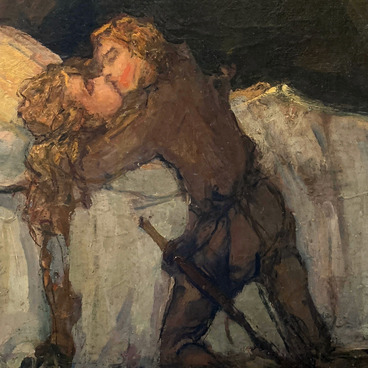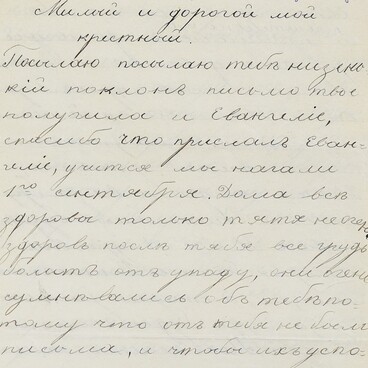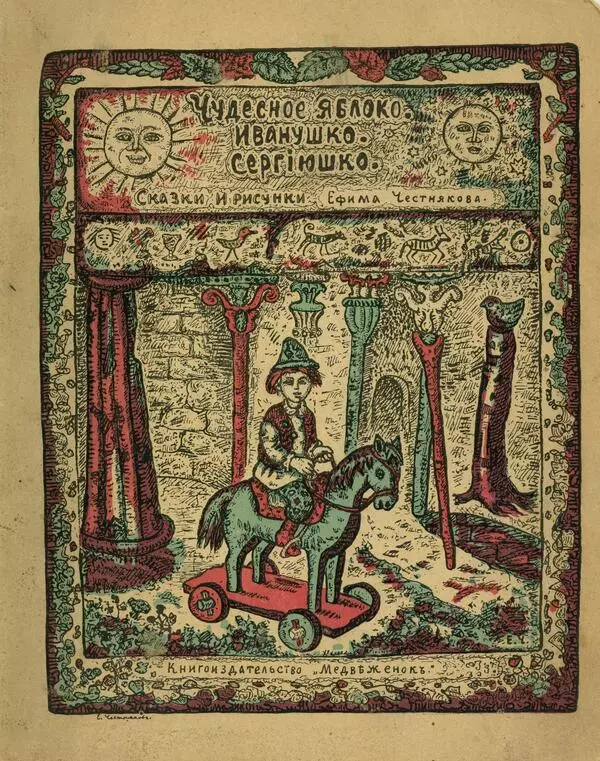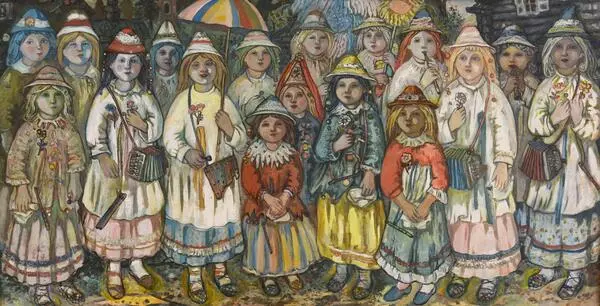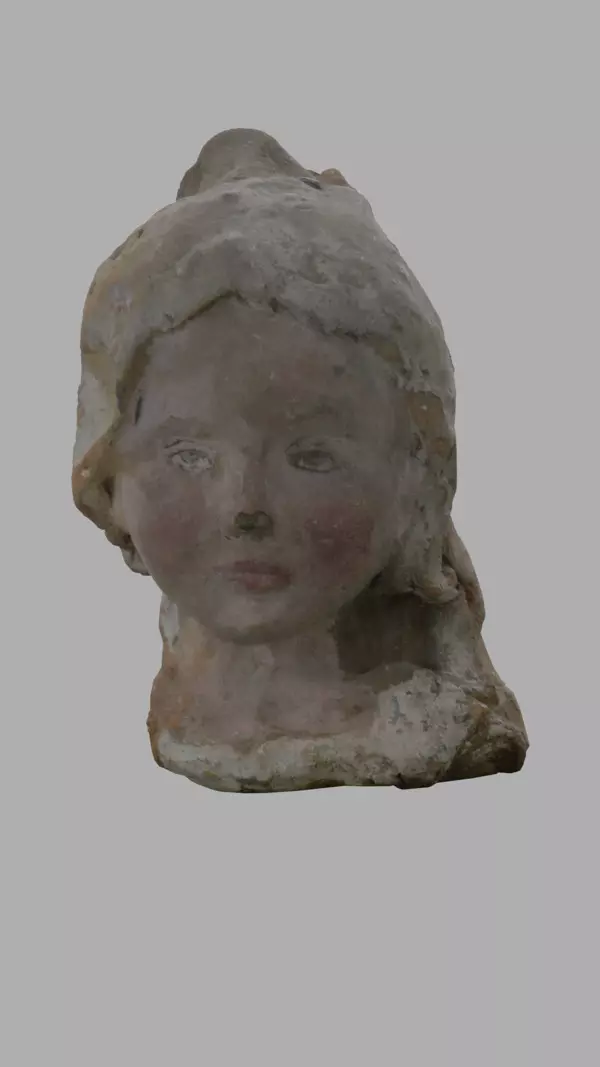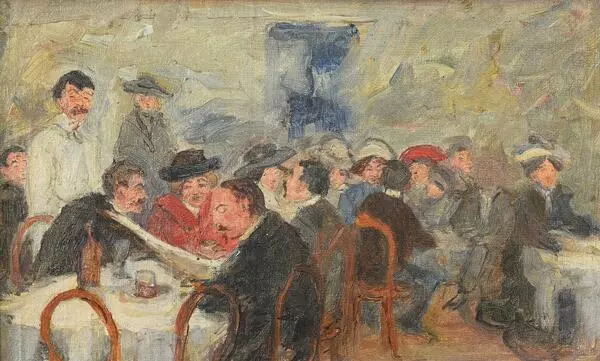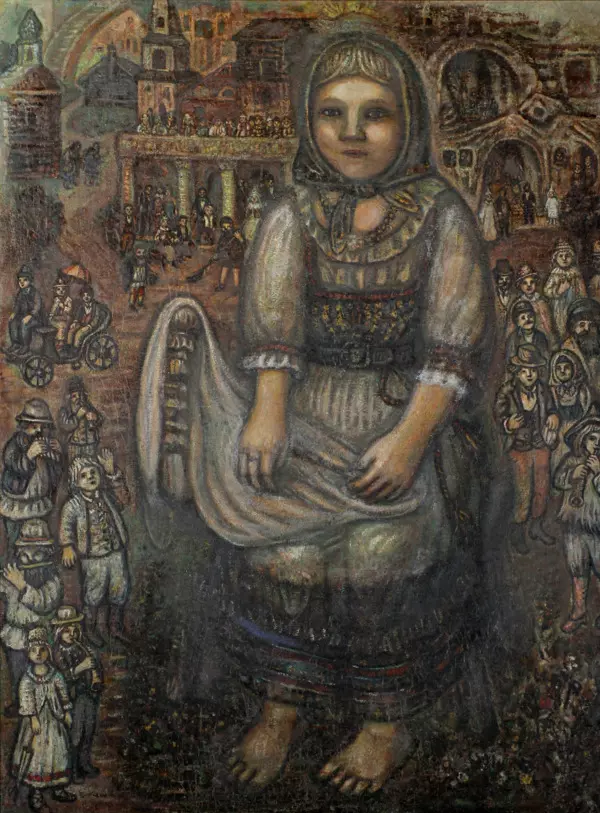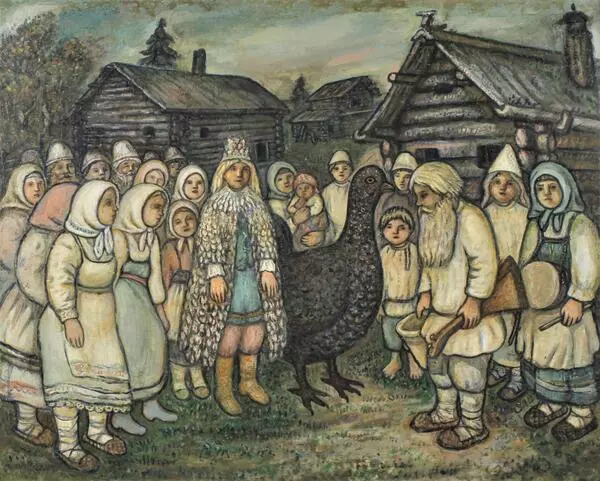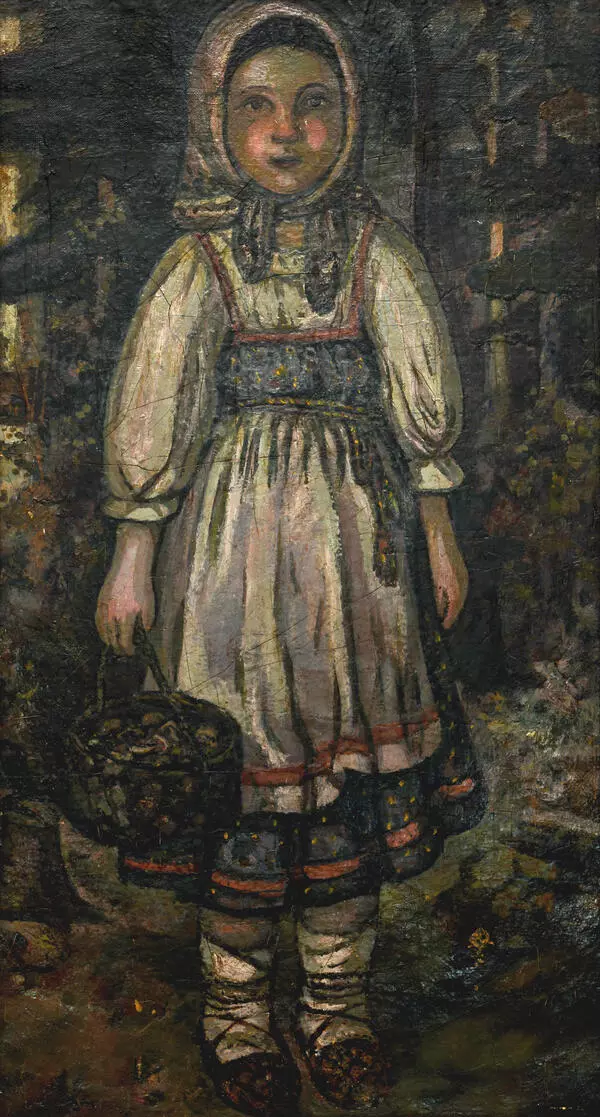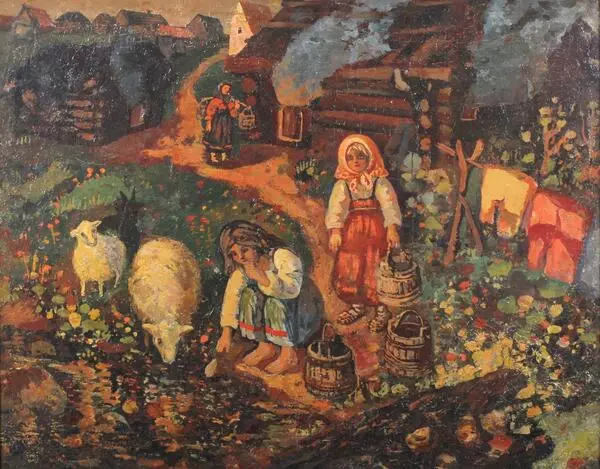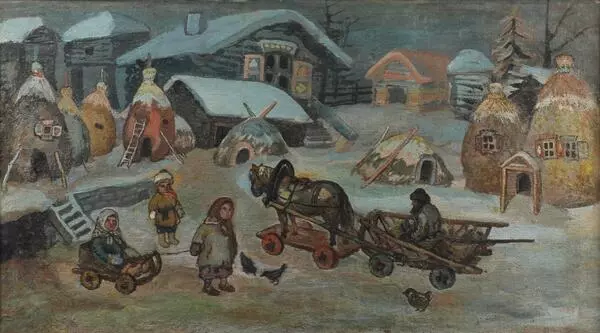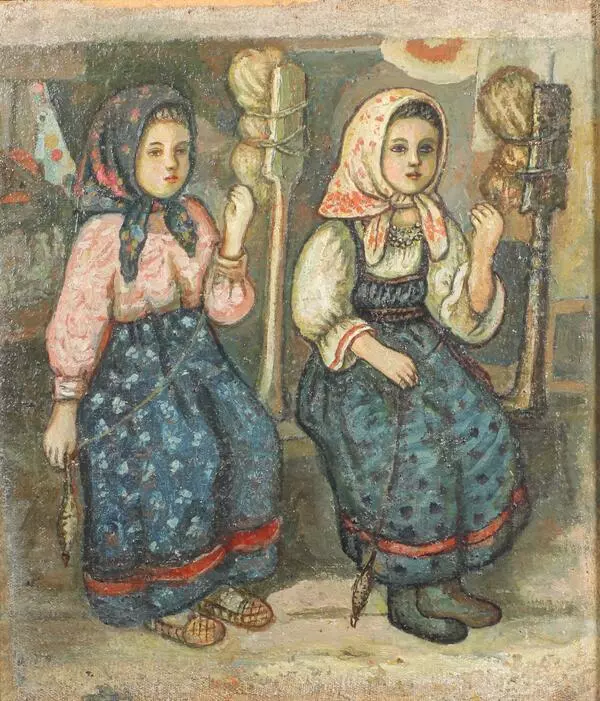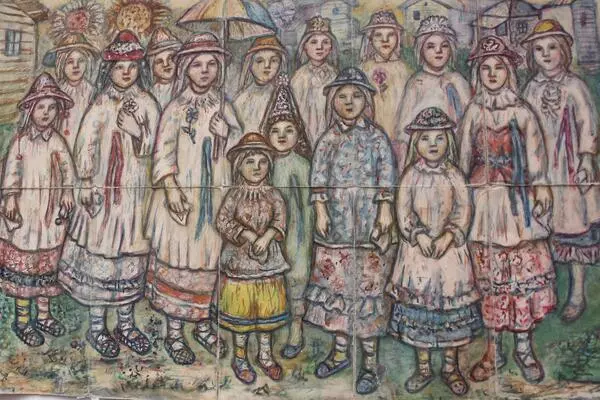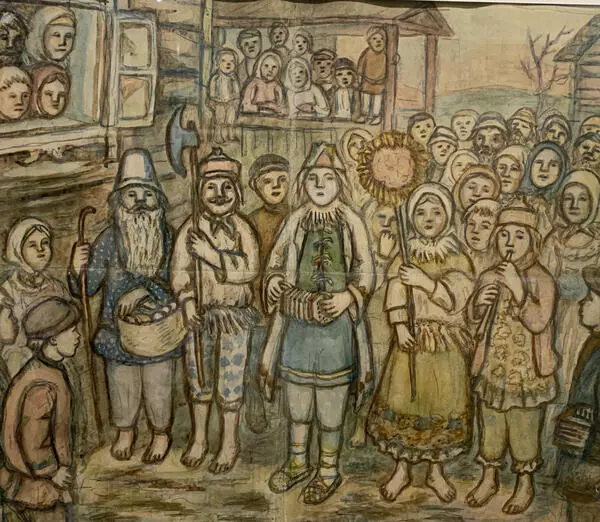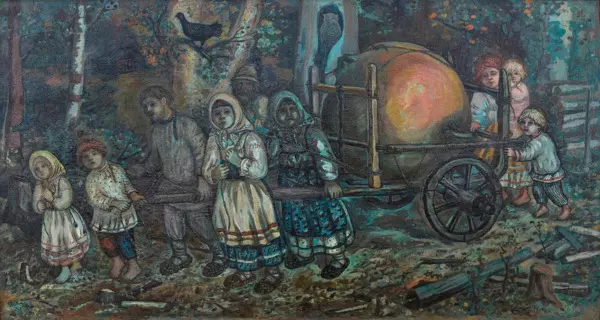Yefim Chestnyakov depicted the essence of his vision of art in his painting ‘A festive procession with song’ (koliada). It shows an ancient custom from Slavic mythology tied to Koliada, which inspired songs about Christmas and the fertile spring season. Koliadki (songs) were performed by youngsters going from door to door. The lyrics included well wishes to households whose heads were generous, and promised ruin to the greedy and the unhelpful.
The painting’s composition can be viewed as consisting of three parts. On the left-hand side of the painting, there is a section of a large log house and a peasant family is looking out of its window. On the right, there is a part of a three-storey stone house with white walls. A crowd of peasants, consisting of women, men and children, is seemingly pouring into the center of the canvas. The lyrics to the koliada, which convey the essence of this work of art, are written out in full by the artist in the upper left-hand corner. The words are revealing, they help one understand the concepts behind the work of art and the significance of some of its figures. On the upper floor of the stone house, its master and mistress as well as their children are sitting at the windows. The aforementioned text is as follows
“In the first window of the stone house,
The master himself, Dorofei Fedotovich,
As luminous as the crescent moon,
Is sitting.
In the second window of the stone house,
The mistress herself, Odariya Trifonovna,
As bright as the sun,
Is sitting.
And in the third window of the stone house,
The young children,
As shiny as the stars,
Have gathered together like flowers in a garden.”
We can see that there is a luminous crescent moon above Dorofei, a sun above Odariya, and stars above the children’s heads.
Below, on the second floor of the stone house, the artist depicted scenes from the life of Dorofei Fedotovich’s family: harvesting grain, letting out cattle to graze and celebrating. On the ground floor, where the family did not live, one can see livestock and spirits that always inhabited a peasant home, Lizun, Kikimora and Sosedushko-domovedushko. Each of them had an important and specific role to play in a peasant household. Sosedushko looked after the livestock in the cattle yard, for instance, by adding extra hay to their pens. Kikimora, his wife, was responsible for cleanliness of pots and spinning (spinners always needed to receive blessings for their work). Lizun was in charge of sour cream, making sure the mistress covered the jugs of milk, etc for the night.
There is a common color scheme to the imagery on the painting. Turquoise and green were the primary hues used in this beautiful work of art. Colorful parts (the clothes of each figure as well as birds and animals) are confined to certain areas of the painting with dark outlines and are perceived as separate, and yet, they seamlessly integrate into the overall layout of the art work. The chosen color palette conveys a certain mood, similar to the one associated with hearing a calm, quiet and yet festive sound of a Russian song being sung by numerous voices.
The painting’s composition can be viewed as consisting of three parts. On the left-hand side of the painting, there is a section of a large log house and a peasant family is looking out of its window. On the right, there is a part of a three-storey stone house with white walls. A crowd of peasants, consisting of women, men and children, is seemingly pouring into the center of the canvas. The lyrics to the koliada, which convey the essence of this work of art, are written out in full by the artist in the upper left-hand corner. The words are revealing, they help one understand the concepts behind the work of art and the significance of some of its figures. On the upper floor of the stone house, its master and mistress as well as their children are sitting at the windows. The aforementioned text is as follows
“In the first window of the stone house,
The master himself, Dorofei Fedotovich,
As luminous as the crescent moon,
Is sitting.
In the second window of the stone house,
The mistress herself, Odariya Trifonovna,
As bright as the sun,
Is sitting.
And in the third window of the stone house,
The young children,
As shiny as the stars,
Have gathered together like flowers in a garden.”
We can see that there is a luminous crescent moon above Dorofei, a sun above Odariya, and stars above the children’s heads.
Below, on the second floor of the stone house, the artist depicted scenes from the life of Dorofei Fedotovich’s family: harvesting grain, letting out cattle to graze and celebrating. On the ground floor, where the family did not live, one can see livestock and spirits that always inhabited a peasant home, Lizun, Kikimora and Sosedushko-domovedushko. Each of them had an important and specific role to play in a peasant household. Sosedushko looked after the livestock in the cattle yard, for instance, by adding extra hay to their pens. Kikimora, his wife, was responsible for cleanliness of pots and spinning (spinners always needed to receive blessings for their work). Lizun was in charge of sour cream, making sure the mistress covered the jugs of milk, etc for the night.
There is a common color scheme to the imagery on the painting. Turquoise and green were the primary hues used in this beautiful work of art. Colorful parts (the clothes of each figure as well as birds and animals) are confined to certain areas of the painting with dark outlines and are perceived as separate, and yet, they seamlessly integrate into the overall layout of the art work. The chosen color palette conveys a certain mood, similar to the one associated with hearing a calm, quiet and yet festive sound of a Russian song being sung by numerous voices.
